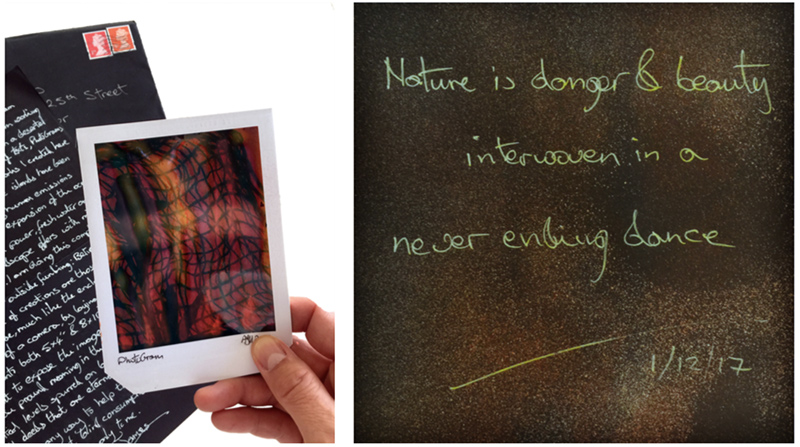Author and an Artist talk about an ECOCIDE practice that produces artworks stimulating climate discussion
Author: Distil Ennui | Post Date: 20-10-2022NB... this conversation took place between July 2020 and August 2021.
Emma Coccioli is the author of 'Animae' Artist interviews, 2018
published by Vernon Press, USA.
A richly illustrated pdf of this article can be downloaded as a research paper here.
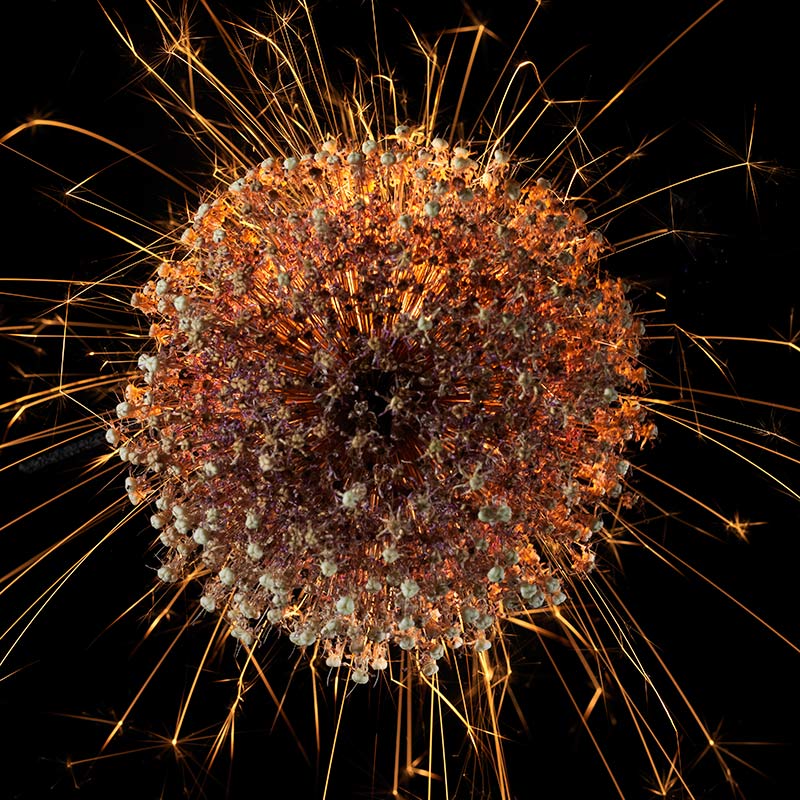
‘Untitled plate 1136’ from ‘Fusion’ dated 2020
EC - Your blooming spheres are literally wonderful. At first glance I was starstruck by the beauty of these strange ‘creatures’ that seem to belong to our familiar environment and at the same time to have been dropped from the sky by some gentle aliens. Soon after I perceived something arcane about them, and started wondering what they are telling us. Each is different from the other, and maybe each has a slightly different message for us?
AJH - These works all centre around the one theme, to reinforce a belief that society is in need of a spiritual re-awakening with nature upon which our future is co-dependent.The sphere representing mother earth. As a geometric shape from all directions it represents to me the infinite, Dutch artist, Maurits Escher, who saw an infinite plane in the sphere's surface.
.jpg)
Escher at work on Sphere Surface with Fish in his workshop, late 1950s
Also representing unity, completeness and the universe. The environment and our encroachment into it has been a constant theme for me to explore in my work for over three decades.
I am fascinated by the concept of the untold billions of specific events that led to us being here at all, how nature is continually evolving all around us.
Here these floral forms are each so very different. From those which seem to be giving birth and giving light, to those at the very precipice of life itself, at the end; shifting form. It brings to mind the moment that we each have here and now; as life is continually renewing itself, each moment so very different than before.
For me this is an important exploration how to present a form so full of beauty and yet at a point of simultaneous tragedy; the way in which we are destroying the air and polluting our rivers and oceans at an ever increasing rate on country and continent wide acts of ecocide and sheer stupidity.
They are each very unique you are quite right Emma; as indeed we are & that of our experience here on earth, with that uniqueness of our very own creation comes a responsibility that we each in our unique way reduce our footprint so as not to plight the experience of those that are to come after our existence has passed.
I believe now is the time for the civil rights movement of our generation to begin.To hold to account the 100 companies that are causing 71% of global pollution for profit. Current corporate PR strategies are to get us to green our own lifestyles; we need to hold to account what they are doing and cleverly guilt spinning us into change, while they remain exactly the same.
Now is a time of action not blind consumption.
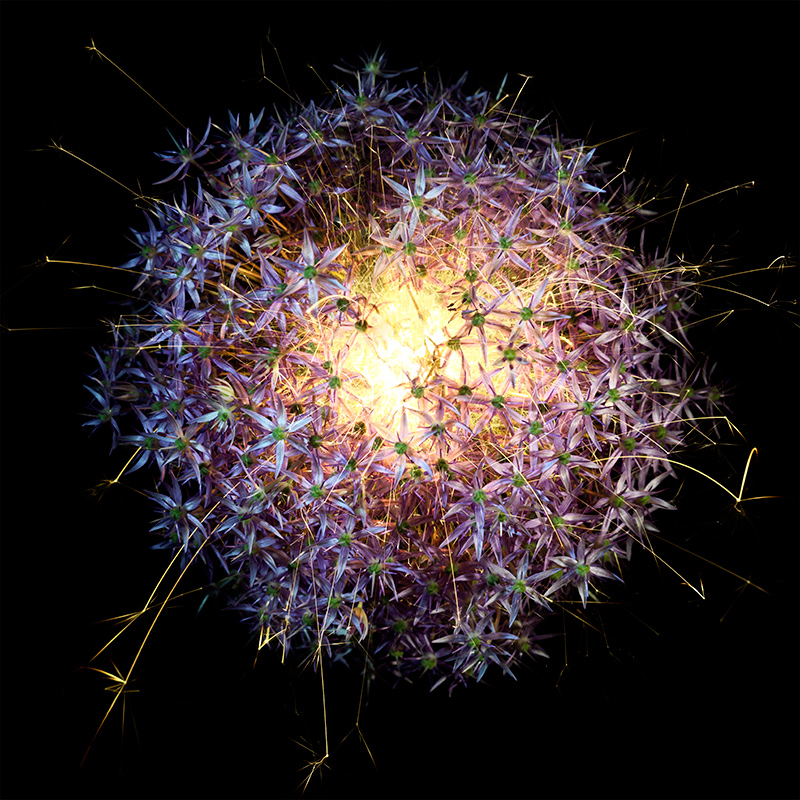
‘Untitled plate 8080’ from ‘Fusion’ dated 2009
EC - After getting lost in the contemplation of the floral spheres, I was also intrigued by the mystery of their creation technically speaking. Do you think you could give us some clues?
AJH - The flowers are all studio grown from specific and ancient specimens of Allium (onion) historically cultivated since the early ages of humanity,This species in particular intrigues me as it is human activity that is causing so many acts of ecocide, the timeframe of onion cultivation and human interference in the natural world seem to be in harmony from a timeline perspective. It also holds a form which I am drawn towards; that of many smaller elements forming into once complex spherical form.
I also introduce other forms of the sphere into the series, from circular mirror surfaces to water formations they are all included in the process of experimentation that created these works; they all occur in camera.The- re is no post production of any kind on these works other than cropping at the final darkroom printing stage.

'Untitled plate 01520' from 'Fusion', dated 2020.
The sparks of energy come from a mix of ground volatile metal filings such as potassium perchlorate, titanium, aluminium and magnesium, I use a holding medium which can help retard or excite the process. I have also used a low voltage / high amperage electrical spark; but as the scale of the project unfolded it became too dangerous in a black water tank.There are such crazy things being tried in the studio.... new things unfolding continually - back to our layered onion it seems !.
EC - The original ideas and intentions you had when you conceived the project ‘Fusion’ and began to work on it have undergone any changes?
AJH - These themes have been a recurring subject in my work for over 30 years, that has always circled the subject of the underwater world, sustainability and ecocide.The protection of global waters is threaded through all my works. Water is the new oil. and its commodification around the planet is well underway. I started this series back in 2010 and re-visited the project on the 10 year anniversary. My initial reasoning burns ever brighter.The works were created as a reaction against the BP Deepwater Horizon incident where 5 million barrels of oil poured into the Golf of Mexico 20th April 2010.The gusher that was left behind after the Deepwater Horizon oil rig exploded and sank. It is still leaking to this date.
Much of my work is in direct contact with the environment, from my many years working underwater on coral reefs to the solitude of my particular renaissance style of studio practice. My projects have seen me travel in a low impact a way such as extended kayak expeditions, living and working alone in the forests of Siberia or on remote desert islands making my own water and power using only the sun; reducing my footprint at every possible stage.This has enabled me to see first hand the devastating effect humanity is having on the natural world, I have always tried to explore these themes through positive interventions in a harmonious way.
In the series ‘Visions from the shoreline’ I documented the jewel like islands in the Atolls of the Maldives over a 30 year period, including above and below the waterline creations. The change to these locations that I have seen in my three decades working on these islands is so dramatic; but through this work just maybe there is a chance to interpret the data in a positive way. Here I free dive and collect detritus from the coral reefs and created a collection of texts, letters and camera-less PolaGram & PhotoGrams created on large format film plates, a process unheard of today. Again only using the sun and natural interventions to explore this one com- mon thread. The project included sending over 150 letters with PolaGrams inside the envelopes, these were sent to environmentalists, political leaders, journalists & editors. around the world to raise awareness for the project, and the worsening plight of our oceans.
This particular project over the full 30 year period has gained full circle status for me just recently, with the July 2021 opening of 'Makers Place'.The first carbon neutral plastic and aluminium recycling facility in the Maldives, The building is designed & completed and the custom made machines that were all hand built to survive a difficult island work life; are all now fully operational.This was enabled working with the Soneva Namoona Foundation who purchased a complete collection of donated artworks and 100% of the funds went directly into funding the completion of this first community changing facility.
The facility is an artists studio where production has already seen island cleanup operations from the area to bring in more raw materials, single use packaging to be re-born into a better end of life than simply being dum- ped in the ocean, buried or worse still burned. It is a terrible plight for small island nations that I am proud to be able to help. Here is the first sculpture from the studio titled ‘Drink Less’, each is made from over 200 beach cleanup coca cola cans.

'Drink Less' made from recycled beach cleanup coca cola aluminium cans
So to answer your question in full, I think no.There have been no changes in the 11 years it took me from start to finish on this Fusion project, its the same conversation; I just think have a wider vocabulary at my disposal as my studio knowledge continues to expand. introducing water and glass was the only technical change.
EC - The sun, creator of life on our planet, and a transfigured presence at the heart of these floral microcosms, is also indissolubly linked to our experience of caducity, a theme that inspired poets of all times all over the world. To me an Italian, there comes immediately to mind two splendid poems born in our land of sunshine, both, paradoxically, with a twilight hue. The first by Catullus – here in the version of Sir Walter Raleigh - dates back to the Roman Empire:
The sun may set and rise, But we, contrariwise, Sleep, after our short light, One everlasting night.
The other, Ed è subito sera, by Salvatore Quasimodo, is two thousand years younger:
Everyone stands alone at the heart of the world pierced by a ray of sunlight,
and suddenly it is evening
Coming back to your work, can you recall any such poems of your background that may have influenced you to some extent?
AJH - My hands and mind are always too busy in the studio to take the time to read as much as I would have liked over the years. Music however has I feel helped to fill that void; my work is very much inspired by such classical masters as Jean Sibelius and Franz Listz. I always have music on in the studio, but never music with lyrics. I enjoy the spatial landscapes music can create. Modern masters such as Ryuichi Sakamoto is a regular to help me experience a broad spread of powerful emotions during the long hours of monastic work solitude.
Thank you for the reminder of Sir Walter Raleighs works, I refreshed my memory after reading your question, but one such poem that does spring to mind for me is Dante Alighieri, Paradiso “Love, that moves the sun and the other stars” I am glad to hold that thought close.
I am hopelessly in love with a memory. An echo from another time, another place.
Black hole & dark matter theory is explored by creating it ‘in camera’
Light, energy & matter are all pulled in by this spheres vast gravitational pull.
presented as shot with no post production or special effects, from ‘Fusion’, dated 2021.
EC - You wrote that the Big Bang is also a powerful actor behind the wings. Again, the theme of the origin and the end of the universe and that of the relation man-physical world commit and fascinate scientists, artists and the man in the streets as well. Nor it could be otherwise. For example, in 2008 there took place an important international exhibition, where eight artists, Alberto Di Fabio, Domenico Bianchi, Dellavedova; Shahzia Si- kander,JamesTurrell,Robert Longo,Ross Bleckner,Peter Halley,‘reflect on the cosmos,science and the infinite’. And, indeed, it was called The Big Bang! From the immense field of science-fiction I pick a very particular film, Last Night (by the Canadian director Don McKellar) that vividly impressed me and still gives me the shivers. It’s so unusual, it describes, in a detailed realistic yet poetic way how people spend their last hours before midnight, deadline of the instant death foretold of everything; and there are no aliens, the villain here, the agent of The End, discovered at the end of the film, is none other than the creator of life, the sun! Regarding Fusion, could you recall for us any similar artistic ‘encounters’ that you recognise as having deeply impressed or influenced you in its gestation?
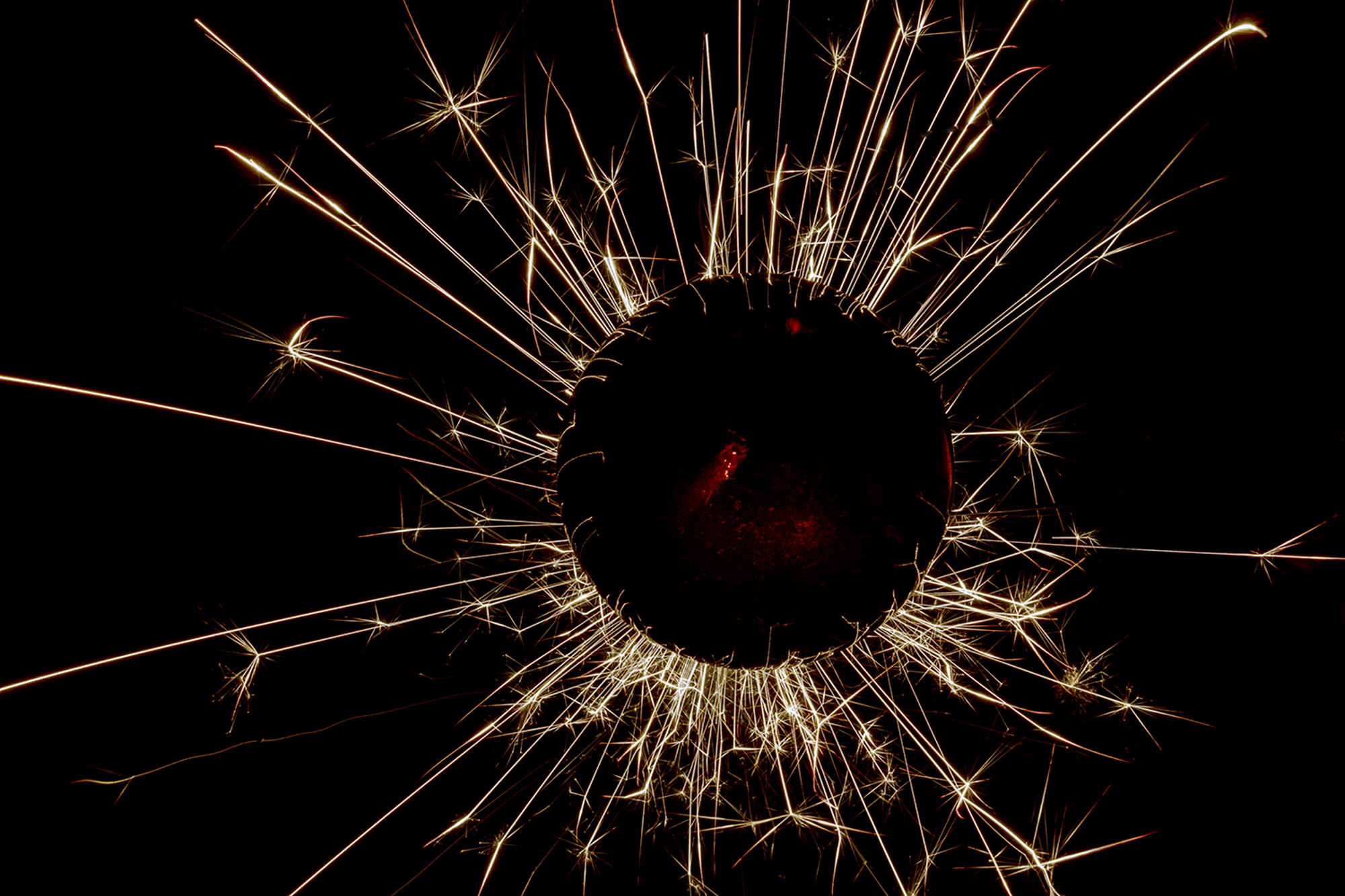
‘Untitled Plate 01566’, from ‘Fusion’ dated 2020.
AJH - I think my early underwater experiments have clearly had a lasting impression on me, that still reverberate constantly to this day. Many of these early underwater installations were well offshore and difficult to swim to, so photography was used to fix and extend the work to allow others access to its reasoning. The decision that water was to be my medium as an artist was firmly set in those early days; it was difficult work and often dangerous. Free diving alone offshore, and tanked on deeper dives, with materials that would fight me in their bid to stay afloat, with inquisitive and often hostile receptions from the underwater residents greeting me below. During this period I dived exhaustively many times a day which over the years has made its mark on me in this compelling spatial environment.
This surely must overlap into ‘Fusion’ with its reference to the infinite and the wonders of the natural world. Images from space continue to extend our knowledge of the universe that continually inspire me to extend what is creatively possible; a new way to present an age old conversation.
EC - Roundness characterises your ‘creatures’. Why this choice? Maybe because the circular shape alludes to the idea of cyclicity of processes in all the main realms of reality, from nature and history to the human existence? Many thinkers and artists, infact, believed in the “eternalreturn” since antiquity, and in more recent times, in the face of the new developments of thermodynamics implying the thermal death of the universe, Frederich Nietzsche reshaped the idea in his own way. A famous passage from The Gay Science reads: “The eternal hour glass of existence is turned upside down again and again and you with it, speck of dust!». Edvard Munch, the painter, shared a similarly grim view, symbolised by the mandrake, or’ blood flower’, represented in his picture The Flower of Pain. At the same time, some say, by incorporating the law of Lavoisier:“Nothing is created, nothing is destroyed, everything is transformed” these philosophical/artistic formulations do express the amor fati, the love of fate, and that of life infinitely repeating itself. Do you recognise any sense in these connections?
AJH - Yes the love of fate, I had not thought of the Edvard Munchs mandrake like this before.Yes of course it is a belief for me that nothing ever dies, it is merely energy moving from one form or place to another. A basic principle of the universe. With loss or pain everything you feel within can be transformed. Of course it is a strong theme threaded in my work and a subject explored throughout art history; its exploration can indeed lead to untrodden paths and painful conclusions. Or it can be transformed into renewed vitality through your work Fate and its unending circle, for me the definition of my success would be time.. time to complete the work and do it justice.
In my analogue photography works, I am excited by the prospect of a pure image, untouched once the image is exposed; everything is edited so much these days; timelessness can only come from purity.
These works are not about the simple emotions that travel up and down us each day, these are the timeless and recurring emotions that all beings think on death, courage and ecstasy. I want these works to convey these emotions to you with absolute clarity.To freeze Frederich Nietzsches fated hourglass just for one perfect moment to capture that sense of expression in the purest form I possibly can.
The sands may be closing in behind you, but you waste your time looking backwards, you are not moving in that direction.
EC - While according to the dominant theories - Big Rip, Big Freeze or Big Crunch - the sun, the earth and the universe are anyway doomed to disappear, at least one important physicist, Alan Guth, holds a more ‘opti- mistic’ hypothesis, namely that the process that gave life to the universe we live in may start anew. But in one way or another, in any case, this nature and this physical world we know will sooner or later fade into nothing- ness. Knowing your heart-felt environmental concern, also conveyed in your work, I wonder if a wakeful awareness that everything will continue to exist in a new form is compatible with the fight for the conservation of the existing environment or it works against it, weakening our forces. I’d like to know your opinion.
AJH - It is an interesting question you pose, that of whether my interventions to protect the current are in fact negatively affecting the proposed future.The theory is there for a troubled mind to ensue pondering such thoughts. But then I am reminded of the beauty of natural events and how they unfold, sometimes with terrible outcomes in the short term, such as forest fires or profound flooding; but then a flurry of life follows closely behind.These as natural events unfold without human intervention. It is a whole other set of dynamics to consider a forest floor full of plastic or other detritus or the rivers that flood are dead of life through pollution induced oxygen depletion or dissolved chemical waste and floating detritus. These are not natural events, they are not in harmony with universal events these are in fact weakening our forces and our experience with spe- cies extinction and red zones within our environment appearing all over, places that are too toxic to go to, they do not fall into the Big Rip/Bang/Freeze theories in the slightest.
EC - Frailty and transience have often been represented in the history of art, from Caravaggio to Bacon, just to mention two great protagonists of the past. Among contemporaries, what comes first to my mind thinking of creation and destruction, is Yves Klein’s work with fire. Are there any artists who have addressed this matter in an original way who have somehow inspired you?
AJH - Caravaggio has been a remarkable inspiration for me as the creator of the first important still life ‘Basket of fruit’ the sheer beauty of its use of light and elegant form, the colour and detail revealing ever more. His figurative works explored and developed the style of tenebrism leading in later years to chiaroscuro where dramatic reveals from black become a dominant theme. ‘The taking of christ’ for example or ‘Judith Beheading Holofernes’ the intensity of these paintings exist as boldly as they do because of the very blacks from where they come. Black is so full of potential, black is the dominant colour of the universe; all things come from it. It is a clear and striking element throughout my work over the decades. from Vanitas I can recall ‘Grace’ the richness in these period flowers again are brought so alive because of the deepest of black water they are depicted in. Once the photograph is taken and the analogue plate developed, the scene is immediately destroyed.The photograph being the only documentary record of it ever having taken place.

‘Grace’ dated 2010 from the series Vanitas 2008 - Ongoing. Chromogenic print 200 x 150cms Artist Proof.
During my time in London, American artist Nancy Fouts also influenced me a greatly.If you are familiar with her work you will know the playful view of the world she had; giving birth to new ideas through re-interpreting everyday household objects using frailty and transience as the key to her playful themes.This together with her incredible studio skillset enabled her to make any idea come to life, regardless of the materials chosen and fabricate it herself. This influenced me greatly as since knowing and experiencing how Nancy worked in the studio it gave me the confidence to explore every material and process I possibly could. Right now in the studio there are so many new materials in various production stages, from sculpture, painting, 3d scanning modelling & printing, electronic builds to aluminium and bronze casting projects. Whilst it is a very exciting time, this is far removed from such a long time working exclusively with analogue photography.
My studio approach is moving with frailty and transience as works, like acid flavoured ping pong balls bouncing and colliding around the space. ideas, objects and texts are constantly placed under or inside one another. Overlapping, folded, reconfigured and examined the results from which were simple re-inserted into the process, one unique artefact evolving into another.Time itself folding as each artworks story was recorded.
Once created its theme is immediately destroyed by moving quickly in another direction. I think this brings us back to that an onion, constantly unfolding new layers.
EC - These ephemeral flowery globes of yours are astonishingly beautiful. But even the tender ordinary dandelion we blow on is full of charming grace. Anyway, the beauty of impermanent things, or the impermanence of beautiful things, has always been celebrated in many ways, but maybe there’s one old touching poem that says it all, at least to me. It was written in 1599 by François de Malherbe, to console a friend for the loss of his young daughter.
But she was of the world where the most beautiful things Have the worst fate;
And rose that she was, she lived what roses live,
The space of one morning. (“Consolation à M. du Périer”)
Could you reveal to us what verses or words or images are enshrined in your mind in relation to your experience or feeling?
AJH - Loss is a recurring theme in my work and was painfully explored in ‘Witness’ from ‘A beautiful announcement of death’ dated 2011-2012. I personally found the exhibition very difficult to complete and I really do not often discuss the matter further, I think these works perfectly depict my emotion from the experience along with Gertrude’s dialogue from Shakespeare's Hamlet....
There, on the pendant boughs her coronet weeds
Clamb'ring to hang, an envious sliver broke.
When down her weedy trophies and herself
Fell in the weeping brook.
Her clothes spread wide,
And mermaid-like awhile, they bore her up.
Which time she chanted snatches of old tunes,
As one incapable of her own distress,
Or like a creature native and endued unto
that element. But long it could not be
Till that her garments, heavy with their drink,
Pulled the poor wretch from her melodious lay
To muddy death.
These same feelings are germinating all around me every single day in nature, with birth and death events forming continually across every plane of experience.You can see these threads continually weaving throughout my work over the decades.
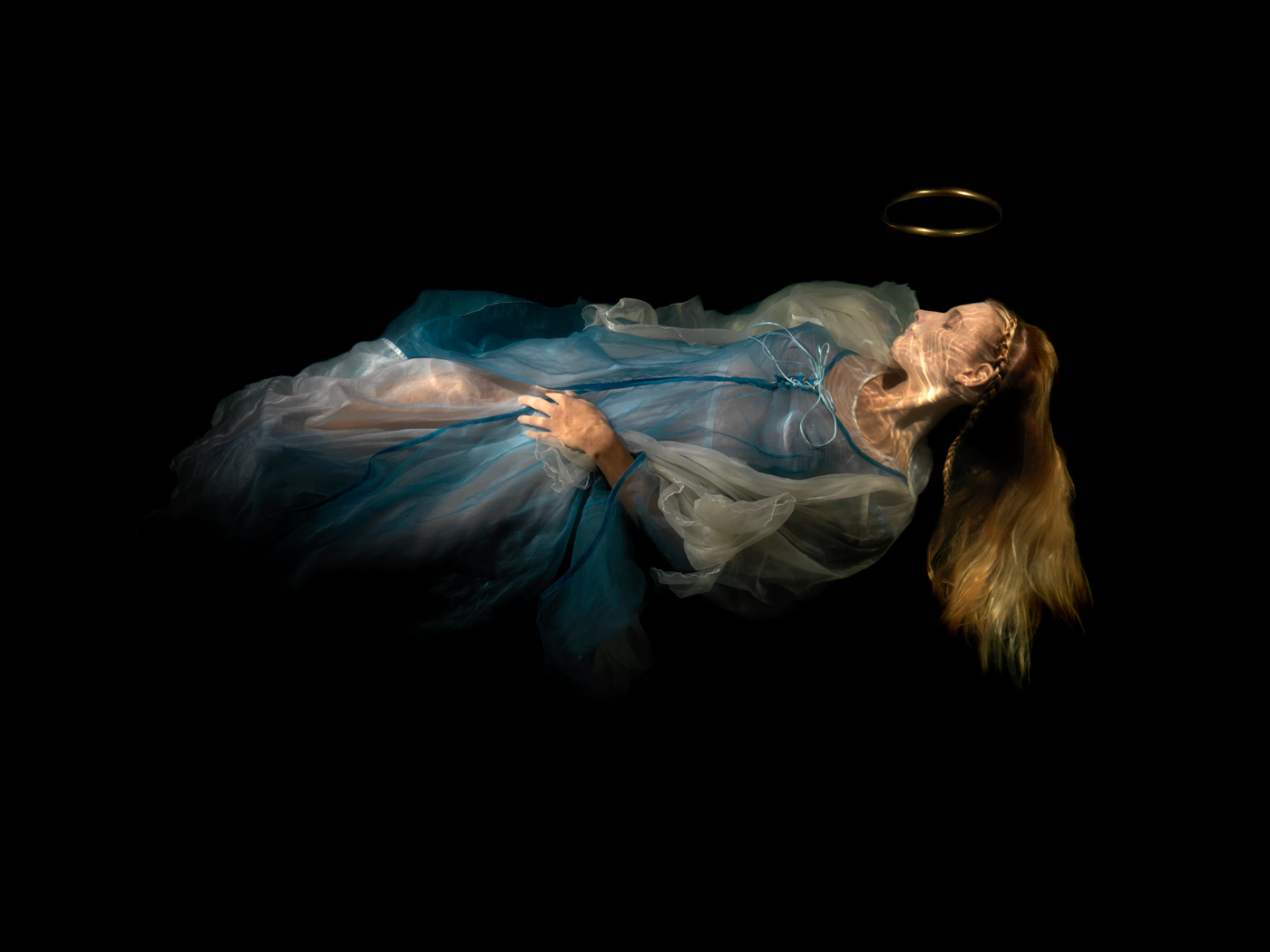
‘Witness’ Martyred Ophelia. from ‘A beautiful announcement of death’ Dated 2012.
Chromogenic print 180 cm x 135 cm Edition of II.
framed behind museum conservation a/r & u/v acrylic 'snug' framed in American walnut.
EC - The smoke emanating from flowers is another element that recurs in some of your works subtly alluding, perhaps, to an early stage of destruction, whereas Adam Fuss, for example, makes it the only gigantic character of one of his series. Being not, in fact, an agent but a by-product of destruction, in the artistic vision smoke becomes mainly a metaphor and a kind of messenger of the end underway. With this in mind, I can’t help thinking of the powerful initial scene of the film Apocalypse now with smoking clouds rising and enveloping the vast palm tree forest while the Doors sing their tragically enchanting song The End. And then there’s the dust, an endless source for artists and poets...And for you, were there any special suggestions, and from which muses, in the creation of Fusion?
AJH - Smoke for me is such an emblematic sign of energy transferring material into an entirely new form, like a butterfly. I believe nothing ever dies its is just energy moving from one form to another.The cadaver in the ground feeding its surrounding life. the burning of material into smoke, energy moving constantly. I try always to make the studio workflow with the same natural flow of energy. One form or creation transforms into another as each material, canvas, an analogue film plate, each overlaps into the other to take the work into new and uncharted territory, I like to work this way; not knowing what is around the corner. I had a lengthy discussion with writer Elouise Stephens on this subject in ‘studio as laboratory’ & how she saw this metaphor at work.....
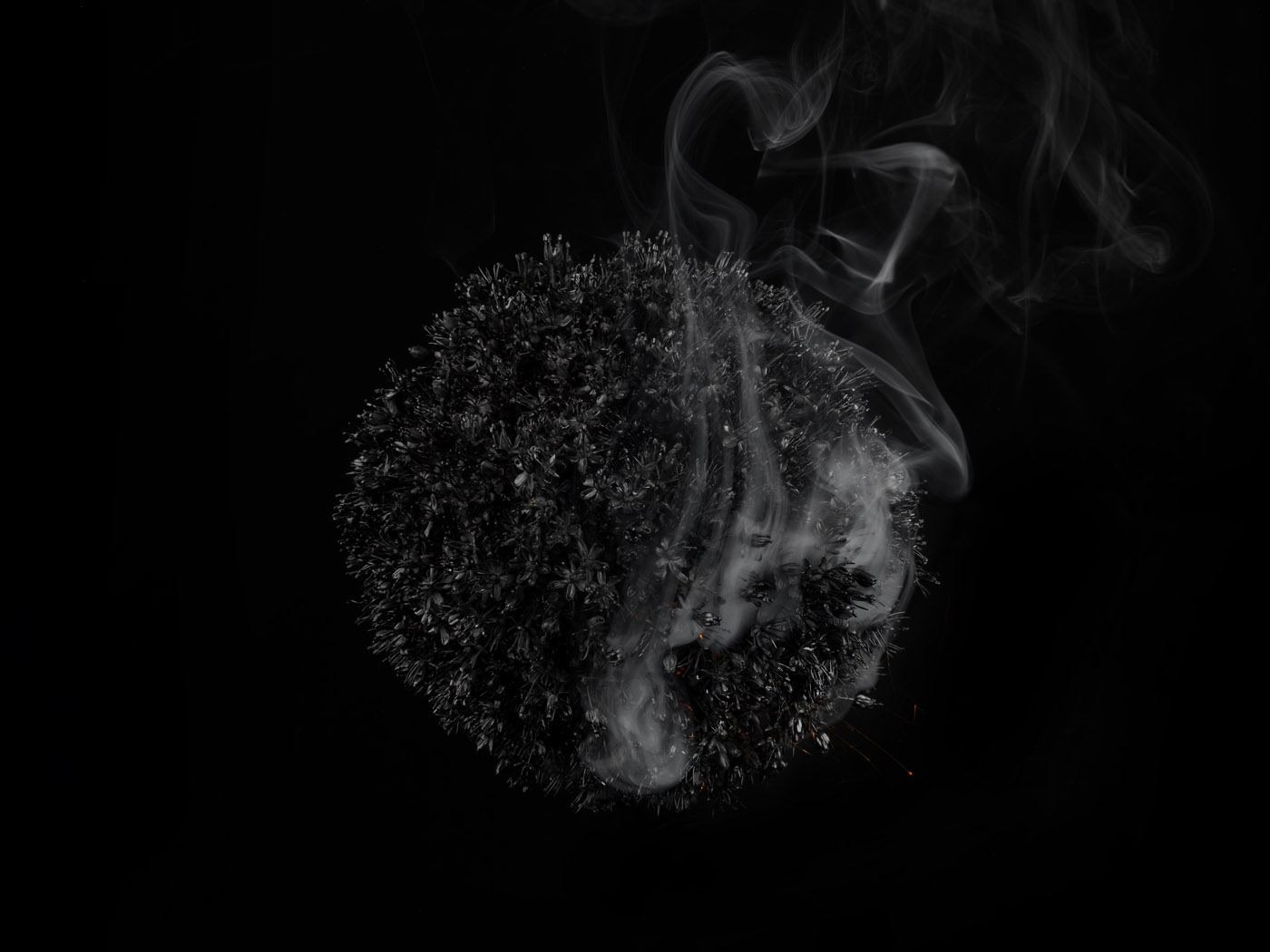
‘Untitled Plate 8502’ from ‘Fusion’, dated 2009.
I must confess to also being fascinated with, and constantly searching for the latest in science and nature based research imagery. For me these serve as primers to new ways of interpreting specific and recurring threads of thought; for example the wonderful resources available online with Nasa including the recent Caseni images that I have been studying closely, of course 10 years ago I explored Fusion purely with floral spheres, the new works definitely look more ‘interstellar in their form’ and I can certainly attest to their origins in my mind as stemming from these new scientific images of exploration.
For example below the Ice Mountains on the outer rings of Saturn are calculated to stand over 5 klms in height and just floating around in space held in this incredible formation and orbital geometric configuration. So much new and exciting imagery and information is coming to us right now; these have undoubtably been a primer and source of inspiration in these new works. As a species we currently have two countries (China and the USA) both with mobile analysis laboratory vehicles exploring Mars, both are equipped with their own drone systems with extensive and highly advanced camera arrays. Being the first humans to see such images in detail cannot be undervalued for me in the studio.
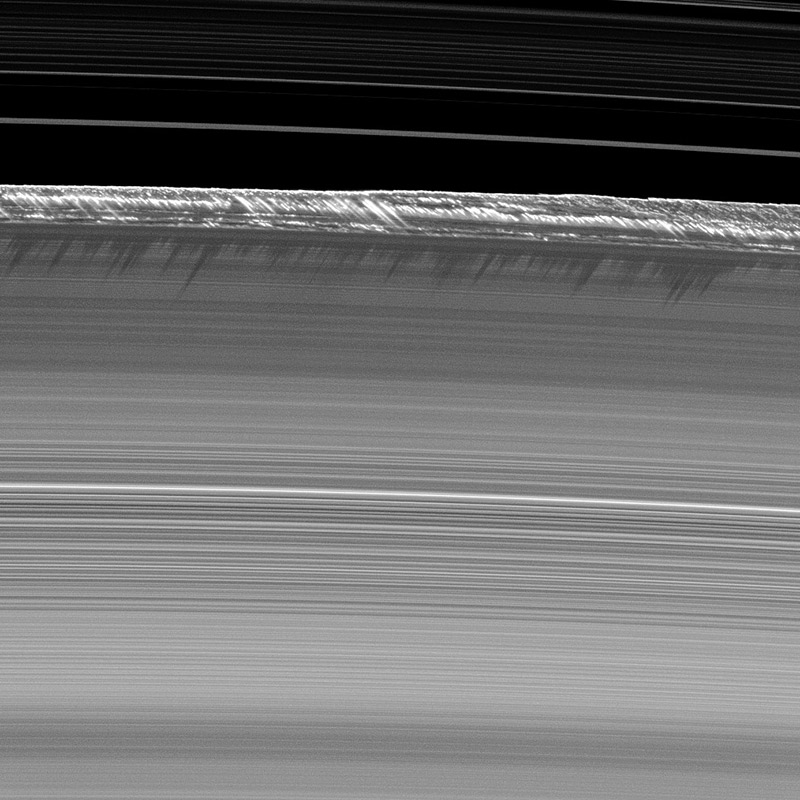
Here we see the vertical ice mountains, these are amongst the tallest seen in Saturn's main rings.
The towering ice formations rise abruptly to 5 klms in height from the edge of Saturn's B ring to cast long shadows on the inner ring which is used to calculate their size precisely.
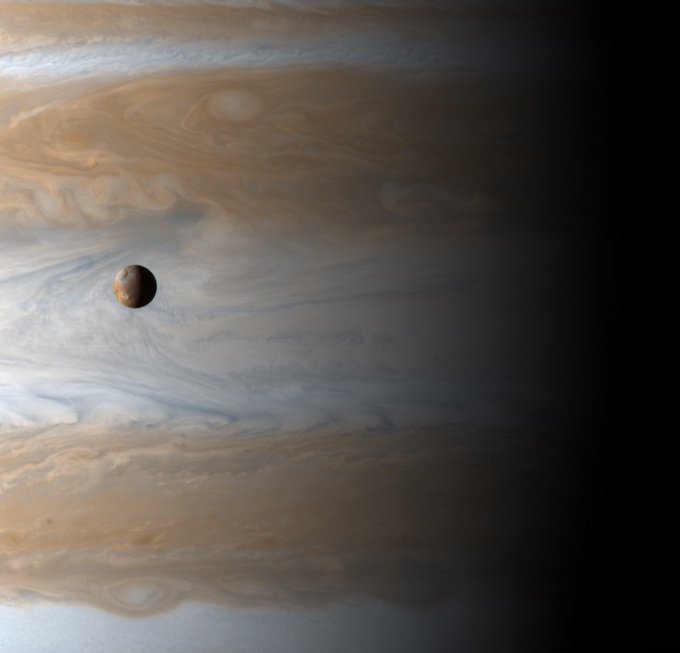
Lo is one of the 79 moons orbiting Jupiter, seen here against the vast backdrop of its parent planet.
This image was taken on the Cassini spacecrafts closest approach to Jupiter on its way to a permanent orbit around Saturn.
Although Io looks very close to the huge planet, it is in fact over 2.5 times Jupiter diameter from the cloud tops pictured behind it. Io is about the size of Earth's moon and has very active volcanoes.
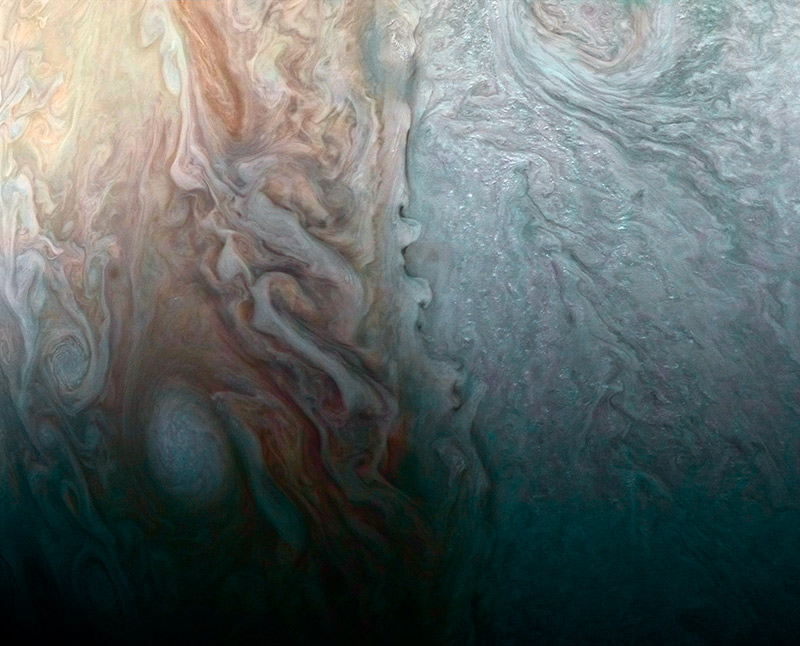
I hope you found this journal entry informative, please stay connected.
Join the mailing list.. Register
Telegram Channel.. DistilEnnui
Instagram.. AJHamilton.Artist
Twitter.. DistilEnnui
Support on Patreon.. SustainableArt
